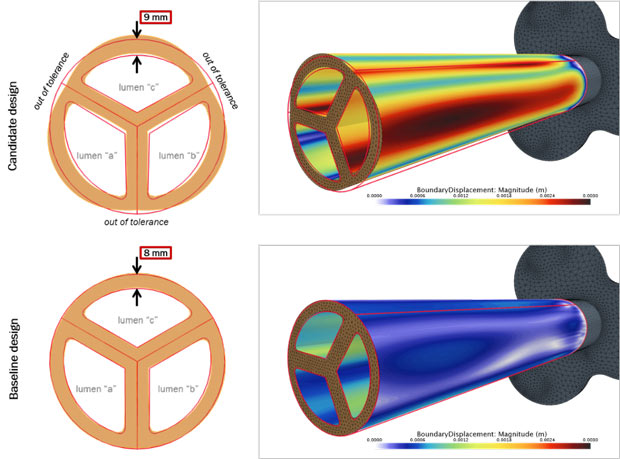Editor’s Pick: STAR-CCM+ v11.02

Beginning with version 11.02, STAR-CCM+ users can combine two or more extrusion materials. The analysis of tri-luminal tubing depicted here shows where and by how much a part has gone out of tolerance. Image courtesy of CD-adapco.
Latest News
March 23, 2016
 Dear Desktop Engineering Reader:
Dear Desktop Engineering Reader:
 CD-adapco just released version 11.02 of its integrated simulation solution for solving problems like fluid flows, heat transfer, solids flows and stress, STAR-CCM+. There’s a lot to say, so no punny opening for today’s Pick of the Week.
CD-adapco just released version 11.02 of its integrated simulation solution for solving problems like fluid flows, heat transfer, solids flows and stress, STAR-CCM+. There’s a lot to say, so no punny opening for today’s Pick of the Week.
STAR-CCM+ v11.02 has a bevy of new capabilities – some 40 alone derived from user suggestions. Two stand out: Local Surface Remeshing and Data Focus. Both nail CD-adapco’s Multidisciplinary Design eXploration (MDX) philosophy.
Fundamentally, MDX melds two principles. One, provide tools that return accurate simulation results so that you can make decisions confidently and expeditiously. Two, provide tools that take on complex analyses yet are easy to use and efficient, enabling you to spend more time productively engineering and less time idling as the software works.Local Surface Remeshing should free up hours of time for real engineering. Well, maybe not at first because you’ll likely find yourself playing around with it just because you can.
The capability lets you remesh selected mesh areas after you change some parameters or finish dealing with a design change. Selected areas means you can remesh one surface, most of your model or anything in between. This way you can avoid remeshing the whole enchilada every time you tweak something.
Data Focus, I’m telling you right now that you should hit the link at the end of today’s main write-up and learn more about this. This is a visualization technique both new and exclusive to STAR-CCM+, according to CD-adapco. It’s not something you’re accustomed to doing, but will likely embrace because it should help you better understand what’s going on with large sets of interdependent data and complex 3D vector fields.
Data Focus lets you link, explore and interrogate live quantitative numerical data and qualitative visual data in scenes interactively. Essentially, you can plot data that was too big to handle previously, create selection filters then create compound sets of multiple selection filters. Finally, you visualize results in a linked 3D scene and update results as desired by dragging around data. Really. Hit the link for a better, deeper explanation.
 STAR-CCM+ v11.02’s new Data Focus technique lets engineers link, explore and interrogate plotted quantitative numerical data and qualitative visual data interactively. Image courtesy of CD-adapco.
STAR-CCM+ v11.02’s new Data Focus technique lets engineers link, explore and interrogate plotted quantitative numerical data and qualitative visual data interactively. Image courtesy of CD-adapco.Additional interesting stuff going on in STAR-CCM+ v11.02 includes new native cylindrical primitive particle types for DEM (discrete element method) modeling and co-extrusion of two or more materials in its Computational Rheology capabilities. Go to today’s Pick of the Week write-up to learn more.
Thanks, Pal. – Lockwood
Anthony J. Lockwood
Editor at Large, Desktop Engineering
Subscribe to our FREE magazine, FREE email newsletters or both!
Latest News
About the Author
Anthony J. Lockwood is Digital Engineering’s founding editor. He is now retired. Contact him via [email protected].
Follow DE





